Gameplay
The player controls Latok, looking onto the game world in bird's-eye view. Latok can swing his sword, optionally firing magical shots from its tip at the expense of magic points, and jump short distances. The player can choose to take along one of a party of four characters on his exploration of the tower. Each of these so-called 'support members' subtly change Latok's statistics, in addition to triggering different events within the game.
The entirety of the Tower is a large labyrinth spanning six floors, each with an elemental theme: darkness for the basement and respectively earth, fire, water, wind and heaven for the first through fifth floors. The game is one large puzzle with the goal of reaching the bottom floor and defeating Zegraya and Gazzel there. Many of the puzzles revolve around the fact the floors are heavily interconnected. On the floor of fire for example, there is a large wall of flames that Latok cannot pass through in any way. On the water floor above, there is a large door that once opened, pours a large amount of water into a hole in the floor, dousing the flames below.
Another part of the puzzles involves the choice of which support member to take along. Support members don't just affect Latok's combat statistics, but some points in the game can only be passed with the right support member tagging along. There are even items in the game that Latok cannot use himself, but the right support member can. As an example, Latok finds a magical scroll with a lightning spell inscribed, but doesn't master enough magic to cast them himself. On a certain part of the first floor, there is a seemingly impassable wall of rubble. When Fray is selected as a support member, she will snatch the lightning scroll from Latok and use it to blast a path through the rubble.
The game can only be saved at a fixed point at the entrance to the tower. To prevent the player having to backtrack just to save his game, various items can be found that will teleport Latok and his support member back to the entrance or to a fixed point inside the tower.
Contrary to its predecessors, The Tower of Gazzel does not use an experience point system, nor does currency of any kind appear in the game. Latok starts the game at level 50, as he was at the end of Xak II, and does not advance; this instead occurs in Xak III . New equipment is also unavailable, Latok sticks with the sword, armor and shield he had at Xak II's end throughout this game. This eliminates the need for the player to spend large amounts of time on 'leveling up', collecting enough experience points and/or gold to have the player character grow strong enough or buy new equipment, respectively. In this way, the game's emphasis is more on the puzzle aspect than on the combat. A kind of advancement system is retained in that Latok can find different pairs of gauntlets in the tower, each pair enhancing his combat statistics further.
The game engine is almost identical to Xak II's preserving the real-time combat aspect. Some music and graphics were even recycled from the previous installment. Compared to Xak II, The Tower of Gazzel runs much smoother even on a regular MSX2, prompting for much less and shorter loading times.
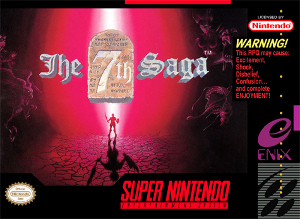
The 7th Saga is a turn-based role-playing video game developed by Produce! and published by Enix for the Super Nintendo Entertainment System in 1993. The game made innovative use of a radar system during gameplay. It featured 7 playable characters of various types including humans, an elf, a dwarf, robots, a demon, and an alien. Each character has unique items and spells.

Beyond Zork is an interactive fiction computer game written by Brian Moriarty and released by Infocom in 1987. It was one of the last games in the Zork series developed by Infocom. It signified a notable departure from the standard format of Infocom's earlier games which relied purely on text and puzzle-solving: among other features, Beyond Zork incorporated a crude on-screen map, the use of character statistics and levels, and RPG combat elements.

Mystic Towers is an isometric platform game developed by Animation F/X, and published in 1994 by Manaccom domestically and Apogee Software internationally. Originally exclusive to MS-DOS compatible operating systems, it was re-released on Steam in 2015 with Microsoft Windows and Mac OS support. It stars Baron Baldric, an old wizard with a magic staff and an array of amusing mannerisms, who must quest through twelve towers and rid them of monsters. Mystic Towers is a sequel to Baron Baldric: A Grave Adventure, a platform game in which Baron Baldric battled an evil sorcerer ancestor.

Wizard's Crown is a top-down role-playing video game published by Strategic Simulations in 1986. It was released for the Atari 8-bit computers, Atari ST, IBM PC compatibles, Apple II, and Commodore 64. A sequel, The Eternal Dagger, was released in 1987.

Suikoden II is a role-playing video game developed and published by Konami for the PlayStation video game console and the second installment of the Suikoden video game series. It was released in late 1998 in Japan, 1999 in North America, and in 2000 in Europe. The game features a vast array of characters, with over 100 recruitable characters, of which over 40 are usable in combat.
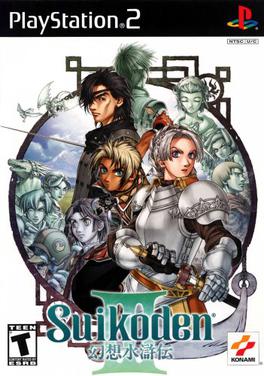
Suikoden III is a role-playing video game developed by Konami Computer Entertainment Tokyo and published by Konami for the PlayStation 2 video game console, and the third installment in the Suikoden video game series. It was released in 2002 in Japan and North America, with a manga adaption published in 2004.
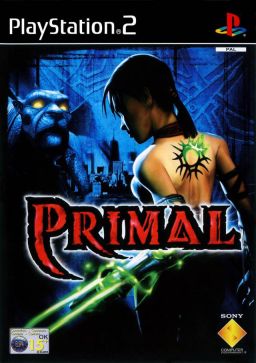
Primal is an action-adventure horror video game developed by SCE Studio Cambridge and published by Sony Computer Entertainment for PlayStation 2. It tells the story of Jennifer Tate, a 21-year-old woman searching for her boyfriend through a series of demonic realms. As the story develops, more is revealed about Jen's past and her relationship with her boyfriend, as well as the nature of the demon worlds.
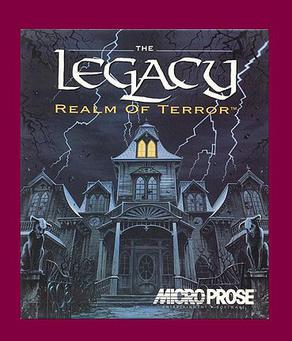
The Legacy: Realm of Terror is a horror role-playing video game developed by Magnetic Scrolls and published by MicroProse for the PC DOS in 1992–1993. A special collector's edition was released by RadioShack. A cancelled version of the game for the Amiga was in development in 1993. It was released digitally on December 20, 2019 by Piko Interactive on GOG.com with support for Microsoft Windows, macOS, and Linux pre-packed with DOSBox.
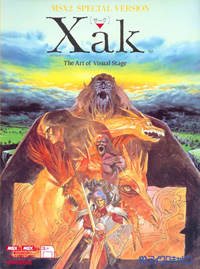
Xak: The Art of Visual Stage (サーク) is the first game in the fantasy role-playing video game series Xak developed and published by Microcabin. It was originally released for the PC-88 computer system, with subsequent versions being developed for the PC-98, X68000, MSX2, PC Engine, Super Famicom, and mobile phones. The first four versions were re-released for Windows on the online store Project EGG. An English translation of Xak: The Art of Visual Stage was also released in 2007 on the now-defunct retro gaming service WOOMB.net, and became available on Project EGG.

Xak II: Rising of the Redmoon is a fantasy role-playing video game developed and published by the Japanese software developer Microcabin. It is a direct sequel to Xak: The Art of Visual Stage. The game was released in Japan only, but due to a MSX scene that arose in Europe some of the MSX versions of Xak received fan translations. An enhanced remake was later released for the PC Engine, together with the first game in the series Xak as Xak I & II by Telenet Japan's development team Riot.
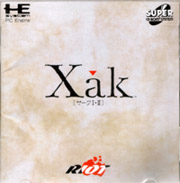
Xak I & II is a re-release of Xak (1989) and Xak II (1990), a fantasy role-playing video game series Xak developed and published by the Japanese software developer Microcabin and Telenet Japan's development team Riot. This set contains both the first two Xak series games back-to-back on one complete Super CD-Rom^2 with enhanced graphics and sound. In a similar style to Ys I & II, also for the PC Engine system, Xak II, the second game in the series picks up immediately as the first game concludes. Xak I & II was a Japanese release only and although the first two Xak games have been translated into English on the MSX2, the PC Engine versions remain untranslated for now.

Fray in Magical Adventure, also known as just Fray (フレイ) and Fray-Xak Epilogue (Gaiden), is a 1990 spin-off "gaiden" (sidestory) game in a role-playing video game series Xak developed and published by the Japanese software developer Microcabin. Even though it is directly connected to the more serious Xak storyline, Fray has a less serious tone and light-hearted comedic approach to telling the story. It was originally released for the MSX2 and was later ported to several different systems, among them MSX Turbo R, PC-98, PC Engine, and Game Gear.

The Tower of Cabin is an unusual spinoff of the fantasy role-playing video game series called Xak by the Japanese developer Microcabin. The Tower of Cabin was released just before Microcabin decided to discontinue the development of Xak III for MSX. The Tower of Cabin was also ported to the PC-98. In this game, the player plays as a new Microcabin employee as they wander the Microcabin headquarters building in Japan with a goal to work with the various lead programmers and developers in making the company more successful. This is very similar to the later Japanese game known as Segagaga (Dreamcast) in which the player runs the entire Sega company as the president of Sega Corporation. This game featured many characters from the Xak series such as Latok, Fray and Pixie. There were two unlockable mini-games in The Tower of Cabin: a short fighting game between Pixie and Fray and a text adventure called Crusader that took place within the Xak universe.
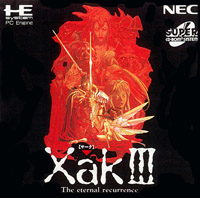
Xak III: The Eternal Recurrence is the final game in a fantasy role-playing video game series called Xak developed and published by the Japanese software developers Microcabin and NEC. Xak III was originally under development to be released for the MSX2 but shortly after Xak: The Tower of Gazzel was released, the development project was halted. After several years the project was continued and finally released simultaneously for the PC-98 and FM Towns. A year later, Xak III was released for the PC Engine CD; this version has since been unofficially translated into English.
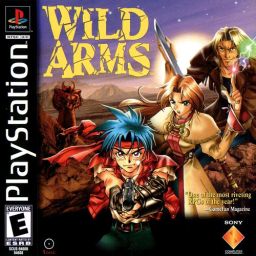
Wild Arms is a role-playing video game developed by Japanese company Media.Vision. Originally released in Japan in 1996 for the PlayStation, it was later translated and released in North America in 1997 and Europe in 1998 by Sony Computer Entertainment. It features a fantasy setting and motif and 2D computer graphics for normal gameplay, while battle sequences are rendered in 3D.

Infinity Blade II was an action role-playing video game for iOS developed by Chair Entertainment and Epic Games. The game was the sequel to Infinity Blade by the same developers.

The Keep is a role-playing video game developed and published by Cinemax.

The Elder Scrolls: Legends is a free-to-play digital collectible card video game, published by Bethesda Softworks for Microsoft Windows, iOS, macOS and Android in 2017.

Magic: The Gathering – Puzzle Quest is a puzzle video game that combines the gem-matching concept in Puzzle Quest and its sequels, with the collectible card game aspects of Magic: The Gathering. It was released for mobile systems in December 2015.

Summoners War: Sky Arena is a mobile turn-based strategy massively multiplayer online game created by South Korean game developer, Com2uS. The game was announced and released at the Electronic Entertainment Expo on June 12, 2014 for iOS and Android devices. Summoners War has performed successfully, with 200,000,000 downloads worldwide, and $2.100 billion in earnings. In 2020, the game had a crossover with the Street Fighter series, adding characters Ryu, Chun-Li, Ken Masters, M. Bison, and Dhalsim as monsters to the game.


















